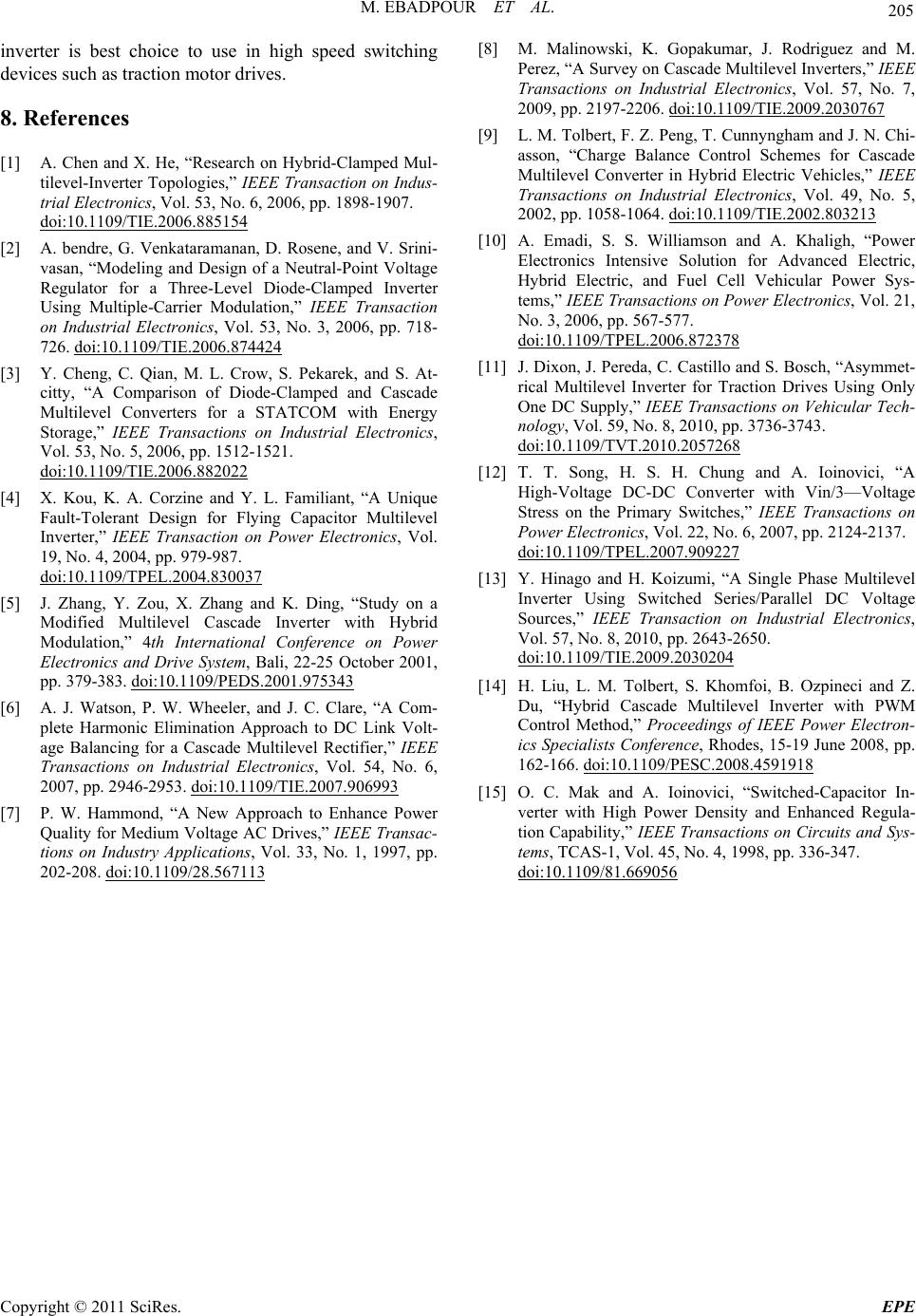
M. EBADPOUR ET AL.
Copyright © 2011 SciRes. EPE
205
inverter is best choice to use in high speed switching
devices such as traction motor drives.
8. References
[1] A. Chen and X. He, “Research on Hybrid-Clamped Mul-
tilevel-Inverter Topologies,” IEEE Transaction on Indus-
trial Electronics, Vol. 53, No. 6, 2006, pp. 1898-1907.
doi:10.1109/TIE.2006.885154
[2] A. bendre, G. Venkataramanan, D. Rosene, and V. Srini-
vasan, “Modeling and Design of a Neutral-Point Voltage
Regulator for a Three-Level Diode-Clamped Inverter
Using Multiple-Carrier Modulation,” IEEE Transaction
on Industrial Electronics, Vol. 53, No. 3, 2006, pp. 718-
726. doi:10.1109/TIE.2006.874424
[3] Y. Cheng, C. Qian, M. L. Crow, S. Pekarek, and S. At-
citty, “A Comparison of Diode-Clamped and Cascade
Multilevel Converters for a STATCOM with Energy
Storage,” IEEE Transactions on Industrial Electronics,
Vol. 53, No. 5, 2006, pp. 1512-1521.
doi:10.1109/TIE.2006.882022
[4] X. Kou, K. A. Corzine and Y. L. Familiant, “A Unique
Fault-Tolerant Design for Flying Capacitor Multilevel
Inverter,” IEEE Transaction on Power Electronics, Vol.
19, No. 4, 2004, pp. 979-987.
doi:10.1109/TPEL.2004.830037
[5] J. Zhang, Y. Zou, X. Zhang and K. Ding, “Study on a
Modified Multilevel Cascade Inverter with Hybrid
Modulation,” 4th International Conference on Power
Electronics and Drive System, Bali, 22-25 October 2001,
pp. 379-383. doi:10.1109/PEDS.2001.975343
[6] A. J. Watson, P. W. Wheeler, and J. C. Clare, “A Com-
plete Harmonic Elimination Approach to DC Link Volt-
age Balancing for a Cascade Multilevel Rectifier,” IEEE
Transactions on Industrial Electronics, Vol. 54, No. 6,
2007, pp. 2946-2953. doi:10.1109/TIE.2007.906993
[7] P. W. Hammond, “A New Approach to Enhance Power
Quality for Medium Voltage AC Drives,” IEEE Transac-
tions on Industry Applications, Vol. 33, No. 1, 1997, pp.
202-208. doi:10.1109/28.567113
[8] M. Malinowski, K. Gopakumar, J. Rodriguez and M.
Perez, “A Survey on Cascade Multilevel Inverters,” IEEE
Transactions on Industrial Electronics, Vol. 57, No. 7,
2009, pp. 2197-2206. doi:10.1109/TIE.2009.2030767
[9] L. M. Tolbert, F. Z. Peng, T. Cunnyngham and J. N. Chi-
asson, “Charge Balance Control Schemes for Cascade
Multilevel Converter in Hybrid Electric Vehicles,” IEEE
Transactions on Industrial Electronics, Vol. 49, No. 5,
2002, pp. 1058-1064. doi:10.1109/TIE.2002.803213
[10] A. Emadi, S. S. Williamson and A. Khaligh, “Power
Electronics Intensive Solution for Advanced Electric,
Hybrid Electric, and Fuel Cell Vehicular Power Sys-
tems,” IEEE Transactions on Power Electronics, Vol. 21,
No. 3, 2006, pp. 567-577.
doi:10.1109/TPEL.2006.872378
[11] J. Dixon, J. Pereda, C. Castillo and S. Bosch, “Asymmet-
rical Multilevel Inverter for Traction Drives Using Only
One DC Supply,” IEEE Transactions on Vehicular Tech-
nology, Vol. 59, No. 8, 2010, pp. 3736-3743.
doi:10.1109/TVT.2010.2057268
[12] T. T. Song, H. S. H. Chung and A. Ioinovici, “A
High-Voltage DC-DC Converter with Vin/3—Voltage
Stress on the Primary Switches,” IEEE Transactions on
Power Electronics, Vol. 22, No. 6, 2007, pp. 2124-2137.
doi:10.1109/TPEL.2007.909227
[13] Y. Hinago and H. Koizumi, “A Single Phase Multilevel
Inverter Using Switched Series/Parallel DC Voltage
Sources,” IEEE Transaction on Industrial Electronics,
Vol. 57, No. 8, 2010, pp. 2643-2650.
doi:10.1109/TIE.2009.2030204
[14] H. Liu, L. M. Tolbert, S. Khomfoi, B. Ozpineci and Z.
Du, “Hybrid Cascade Multilevel Inverter with PWM
Control Method,” Proceedings of IEEE Power Electron-
ics Specialists Conference, Rhodes, 15-19 June 2008, pp.
162-166. doi:10.1109/PESC.2008.4591918
[15] O. C. Mak and A. Ioinovici, “Switched-Capacitor In-
verter with High Power Density and Enhanced Regula-
tion Capability,” IEEE Transactions on Circuits and Sys-
tems, TCAS-1, Vol. 45, No. 4, 1998, pp. 336-347.
doi:10.1109/81.669056